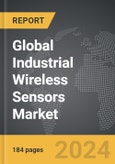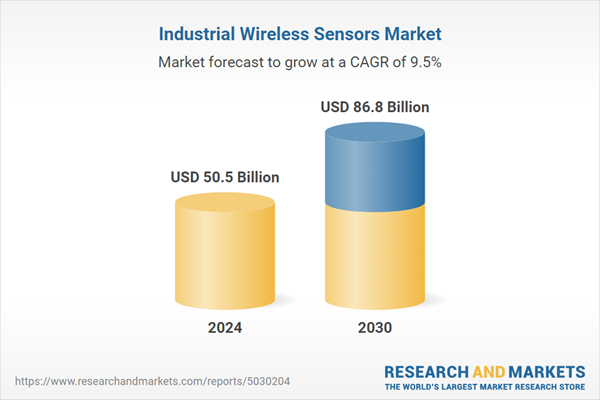Global Industrial Wireless Sensors Market - Key Trends & Drivers Summarized
What Are Industrial Wireless Sensors and How Are They Transforming Industries?
Industrial wireless sensors are devices that monitor and record physical or environmental conditions, such as temperature, sound, pressure, and motion, without the need for physical wires connecting them to a central system. These sensors are crucial in industries for enabling the remote monitoring and control of various operations, thus facilitating improvements in efficiency, safety, and reliability across processes. They harness wireless communication technologies like Wi-Fi, Zigbee, or Bluetooth to transmit data, allowing for flexible installation in locations that are difficult or costly to access with traditional wiring. As industries increasingly adopt smart technology and IoT devices, these sensors are becoming indispensable for real-time data acquisition, condition monitoring, and predictive maintenance, which are all key to minimizing downtime and extending equipment lifespan.How Is Technological Advancement Shaping the Industrial Wireless Sensor Landscape?
The technological landscape of industrial wireless sensors is rapidly evolving, driven by advancements in microelectronics, battery technology, and communication protocols. The miniaturization of electronic components has led to the development of smaller, more energy-efficient sensors that can be deployed in a wider range of settings. Improvements in battery life and power management technologies allow these sensors to operate longer, reducing maintenance frequency and costs. Additionally, the enhancement of wireless communication protocols has increased the reliability and security of data transmission, addressing key concerns in industrial applications. These advancements are not only expanding the capabilities of wireless sensors but also broadening their applications across various sectors including manufacturing, energy, and healthcare.What Market Trends Are Influencing the Adoption of Industrial Wireless Sensors?
Several market trends are significantly influencing the adoption of industrial wireless sensors. Firstly, there is a growing shift towards Industry 4.0, the current trend of automation and data exchange in manufacturing technologies, which integrates IoT, cyber-physical systems, and cloud computing. This trend underscores the need for interconnected devices that can communicate seamlessly to optimize production processes. Secondly, the increasing focus on safety and regulatory compliance across industries has propelled the demand for sensors capable of monitoring environmental and machine health in real-time to prevent accidents and failures. Furthermore, the economic pressure to enhance productivity and reduce operational costs encourages firms to invest in technologies that automate and streamline operations, with wireless sensors playing a pivotal role in achieving these objectives.Growth in the Industrial Wireless Sensors Market Is Driven by Several Factors
The growth in the industrial wireless sensors market is driven by several factors related to technology, end-uses, and consumer behavior. Technologically, the integration of AI and machine learning has enhanced the capability of wireless sensors to analyze data and make intelligent decisions, thus increasing their utility in complex industrial applications. From an end-use perspective, the expansion of industries such as oil and gas, pharmaceuticals, and automotive, where precision and efficiency are paramount, has significantly contributed to the market's expansion. Moreover, consumer behavior towards increased automation and data-driven management in industries propels the demand for these sensors. Companies are increasingly adopting wireless sensors to gain a competitive edge by improving their operational efficiencies and ensuring compliance with environmental and safety regulations. The need for sustainable operations and reduced environmental impact also drives the adoption of these sensors, as they can help monitor and reduce resource wastage, aligning with global sustainability goals.Report Scope
The report analyzes the Industrial Wireless Sensors market, presented in terms of market value (USD). The analysis covers the key segments and geographic regions outlined below.- Segments: Product (Flow Sensors, Pressure Sensors, Temperature Sensors, Gas Sensors, Other Products); End-Use (Industrial, Energy, Other End-Uses).
- Geographic Regions/Countries: World; United States; Canada; Japan; China; Europe (France; Germany; Italy; United Kingdom; and Rest of Europe); Asia-Pacific; Rest of World.
Key Insights:
- Market Growth: Understand the significant growth trajectory of the Flow sensors segment, which is expected to reach US$25.5 Billion by 2030 with a CAGR of 10.6%. The Pressure sensors segment is also set to grow at 8.8% CAGR over the analysis period.
- Regional Analysis: Gain insights into the U.S. market, valued at $13.7 Billion in 2024, and China, forecasted to grow at an impressive 8.8% CAGR to reach $13.4 Billion by 2030. Discover growth trends in other key regions, including Japan, Canada, Germany, and the Asia-Pacific.
Why You Should Buy This Report:
- Detailed Market Analysis: Access a thorough analysis of the Global Industrial Wireless Sensors Market, covering all major geographic regions and market segments.
- Competitive Insights: Get an overview of the competitive landscape, including the market presence of major players across different geographies.
- Future Trends and Drivers: Understand the key trends and drivers shaping the future of the Global Industrial Wireless Sensors Market.
- Actionable Insights: Benefit from actionable insights that can help you identify new revenue opportunities and make strategic business decisions.
Key Questions Answered:
- How is the Global Industrial Wireless Sensors Market expected to evolve by 2030?
- What are the main drivers and restraints affecting the market?
- Which market segments will grow the most over the forecast period?
- How will market shares for different regions and segments change by 2030?
- Who are the leading players in the market, and what are their prospects?
Report Features:
- Comprehensive Market Data: Independent analysis of annual sales and market forecasts in US$ Million from 2024 to 2030.
- In-Depth Regional Analysis: Detailed insights into key markets, including the U.S., China, Japan, Canada, Europe, Asia-Pacific, Latin America, Middle East, and Africa.
- Company Profiles: Coverage of players such as ABB Group, Baumer Group, Curtiss-Wright Corporation, Danfoss A/S, Emersion Electric Co. and more.
- Complimentary Updates: Receive free report updates for one year to keep you informed of the latest market developments.
Some of the 21 companies featured in this Industrial Wireless Sensors market report include:
- ABB Group
- Baumer Group
- Curtiss-Wright Corporation
- Danfoss A/S
- Emersion Electric Co.
- General Electric Company
- Honeywell International, Inc.
- Johnson Controls International PLC
- Jumo AS
- ProTAACS
- Rockwell Automation, Inc.
- SCHMIDT Technology GmbH
- Schneider Electric SA
- Shanghai Yuanben Magnetoelectric Tech Co., Ltd.
- Shenzhen Sensor Electronic Technology Co., Ltd.
- Siemens AG
- Siko GmbH
- Texas Instruments, Inc.
- Yokogawa Electric Corporation
This edition integrates the latest global trade and economic shifts into comprehensive market analysis. Key updates include:
- Tariff and Trade Impact: Insights into global tariff negotiations across 180+ countries, with analysis of supply chain turbulence, sourcing disruptions, and geographic realignment. Special focus on 2025 as a pivotal year for trade tensions, including updated perspectives on the Trump-era tariffs.
- Adjusted Forecasts and Analytics: Revised global and regional market forecasts through 2030, incorporating tariff effects, economic uncertainty, and structural changes in globalization. Includes historical analysis from 2015 to 2023.
- Strategic Market Dynamics: Evaluation of revised market prospects, regional outlooks, and key economic indicators such as population and urbanization trends.
- Innovation & Technology Trends: Latest developments in product and process innovation, emerging technologies, and key industry drivers shaping the competitive landscape.
- Competitive Intelligence: Updated global market share estimates for 2025, competitive positioning of major players (Strong/Active/Niche/Trivial), and refined focus on leading global brands and core players.
- Expert Insight & Commentary: Strategic analysis from economists, trade experts, and domain specialists to contextualize market shifts and identify emerging opportunities.
Table of Contents
Companies Mentioned (Partial List)
A selection of companies mentioned in this report includes, but is not limited to:
- ABB Group
- Baumer Group
- Curtiss-Wright Corporation
- Danfoss A/S
- Emersion Electric Co.
- General Electric Company
- Honeywell International, Inc.
- Johnson Controls International PLC
- Jumo AS
- ProTAACS
- Rockwell Automation, Inc.
- SCHMIDT Technology GmbH
- Schneider Electric SA
- Shanghai Yuanben Magnetoelectric Tech Co., Ltd.
- Shenzhen Sensor Electronic Technology Co., Ltd.
- Siemens AG
- Siko GmbH
- Texas Instruments, Inc.
- Yokogawa Electric Corporation
Table Information
| Report Attribute | Details |
|---|---|
| No. of Pages | 184 |
| Published | December 2025 |
| Forecast Period | 2024 - 2030 |
| Estimated Market Value ( USD | $ 50.5 Billion |
| Forecasted Market Value ( USD | $ 86.8 Billion |
| Compound Annual Growth Rate | 9.5% |
| Regions Covered | Global |









